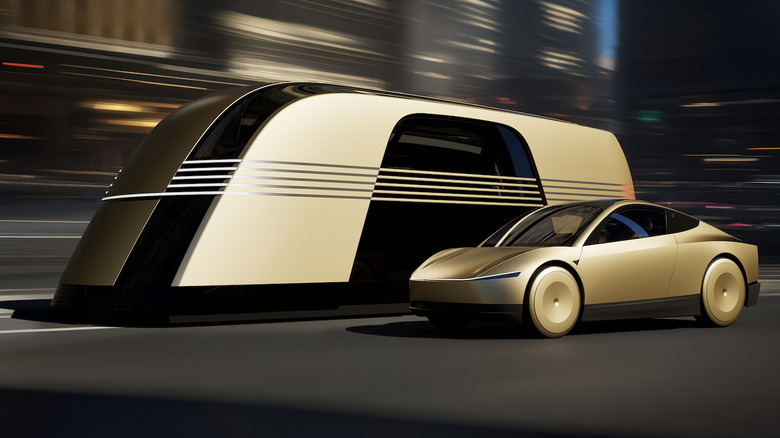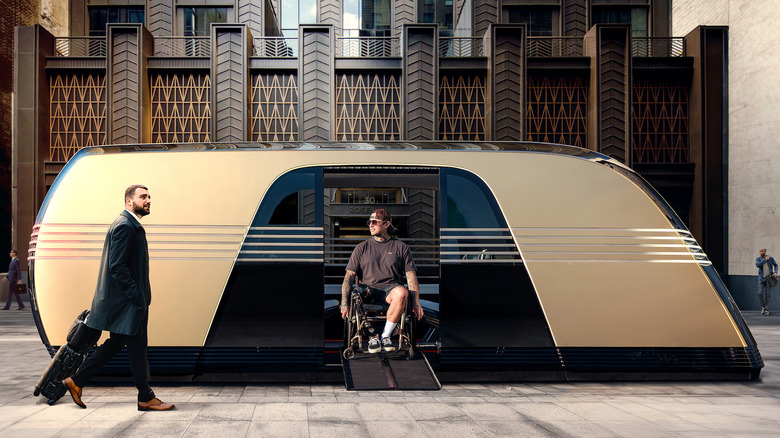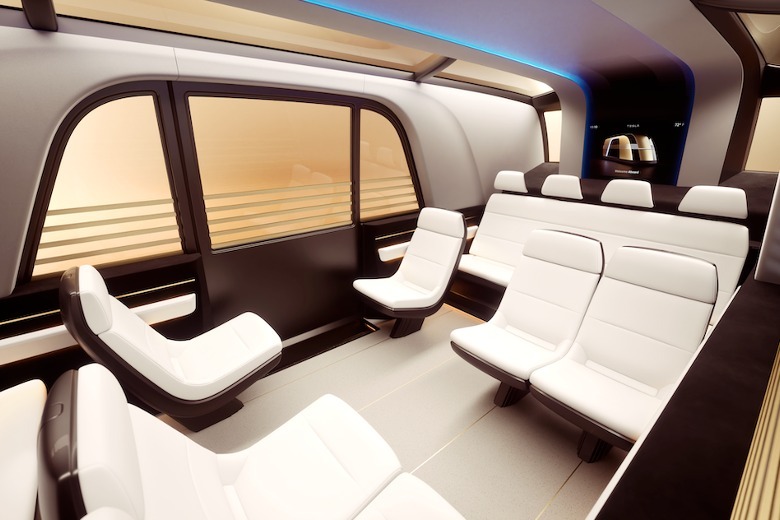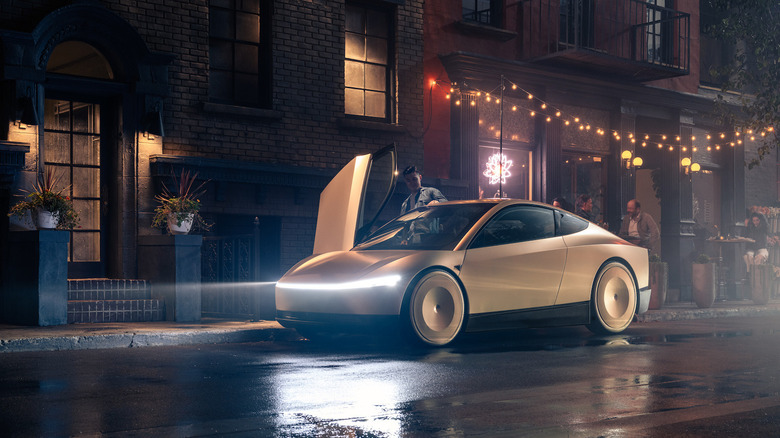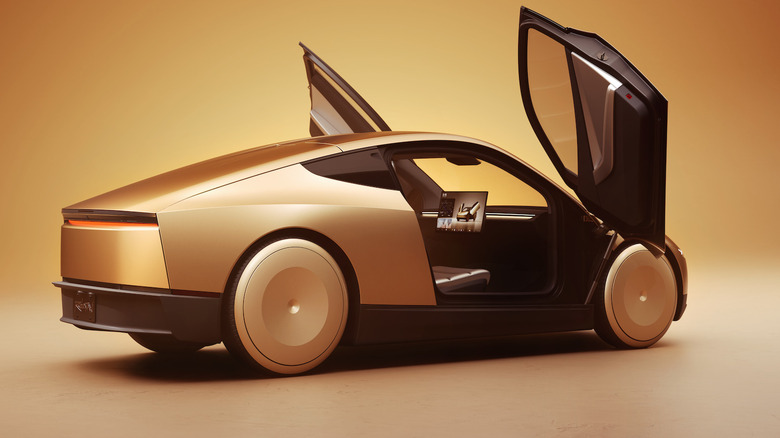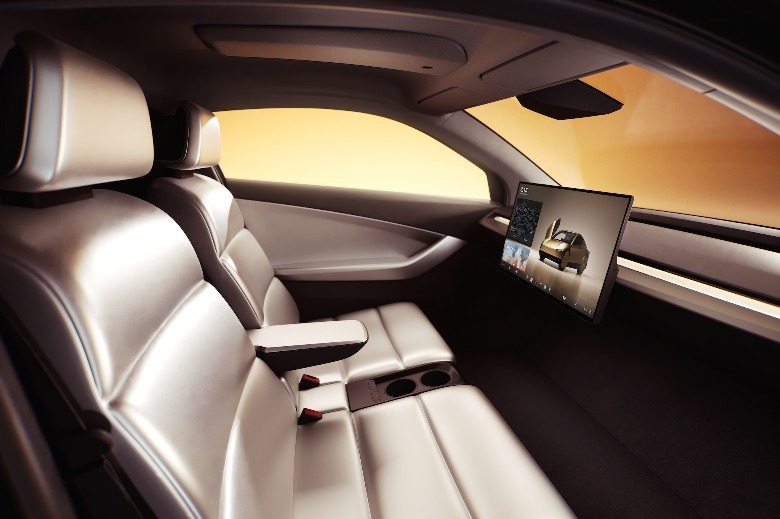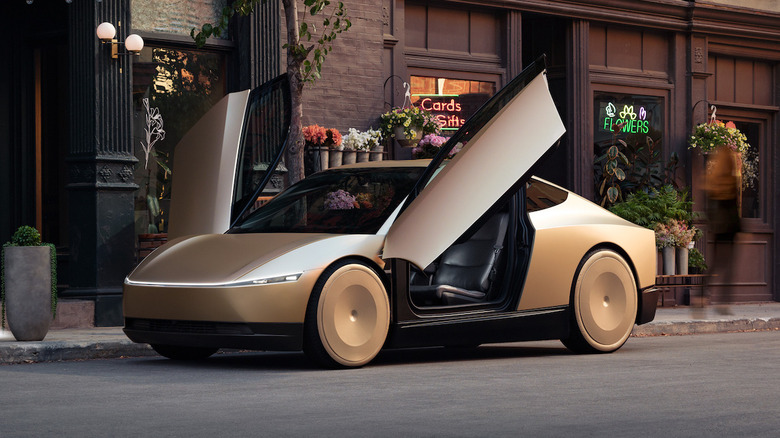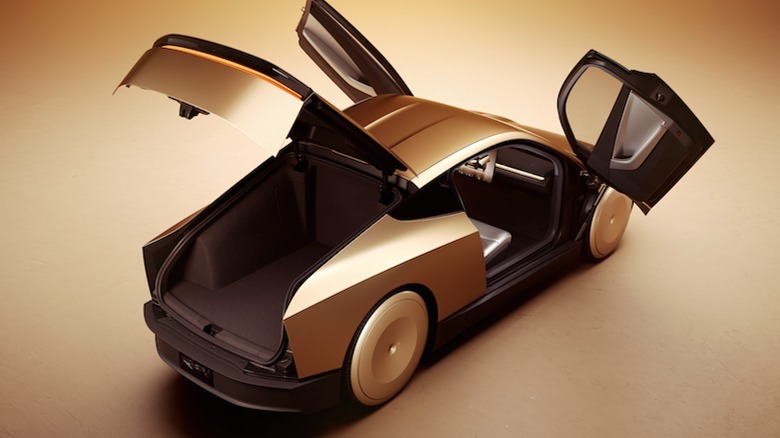Tesla Is Getting Into Robotaxis, And Musk May Have Bitten Off More Than He Can Chew
Elon Musk has unveiled Tesla's new autonomous "Cybercab." The robo-taxi was first announced on Twitter around the same time it was revealed that plans for the Model 2, a more affordable Tesla, were canceled. Musk originally claimed the Robotaxi would be revealed on August 8, but that was eventually pushed back to October 10.
As described by Musk, the Tesla Cybercab will be a Level 4 self-driving vehicle. No steering wheel or pedals are present, so a person couldn't take physical control even if they wanted to. However, as it is running on an upcoming version of Tesla's FSD software, the Model 3 and Model Y will supposedly have the same capabilities. According to Musk, the FSD update in question will roll out next year, and Tesla expects it to initially function in Texas and California.
The Cybercab itself looked pretty sleek, and similar to what the Model 2 was allegedly going to look like. There were also some, admittedly less polygonal, elements of Cybertruck in there, along with a sporty set of butterfly doors. Inside, in addition to just two seats (complete with cupholders) there's a single, central touchscreen.
A Tesla Robovan promises autonomy for up to twenty
There were 20 Cybercabs on site, Musk claimed, so it's safe to assume there are at least 20 prototypes in existence so far. Musk also unveiled a "Robovan" capable of carrying up to 20 people or transporting goods through densely populated areas; the large, striking vehicle could also be used as a mobile store or food truck, it was suggested.
In terms of cost, Musk estimated that current taxis cost around a dollar per mile of transportation, whereas the Cybercab would cost around 20 cents per mile at a basic level, and 30-40 once taxes and other costs were factored in. The "Robovan" is even cheaper, costing as little as $0.10, presumably per passenger, per mile.
It all looks good on paper, but if other robotaxi-based ventures, and Tesla's own FSD experiences, are anything to go by–things aren't going to be that straightforward.
Robotaxis have experienced some issues
Waymo has actually proven to be a pretty safe method of transportation. Its first million miles of travel only saw two full blown "accidents" and 18 "minor contact events," — with over half of those being 100% a human's fault. The humans in question managed to hit a Waymo vehicle when it was stationary. Not all of Waymo's crashes have been human-related though. In June 2024, one of the company's vehicles hit a telephone pole on the way to pick up a passenger. It was also revealed that the NHTSA was investigating Waymo for over 24 incidents which included traffic violations and crashes.
Some of Waymo's competitors haven't been as lucky. Cruise Robotaxis were banished from San Francisco's bay area after an accident saw one of the vehicles drag a woman 20 feet along the road before eventually stopping. Prior to this, the vehicles were witnessed randomly coming to a halt at intersections and blocking roads. All 60 active autonomous taxis lost touch with the server on at least two occasions, leaving them frozen in place.
Parent company GM is currently working to get the self-driving taxis back on the road, but has ditched its plans for a "living room on wheels" style vehicle in favor of one based on the next generation of Chevy Bolt.
Tesla's own self-driving systems have also had their own issues, including one causing a multi-car pileup on San Francisco's Bay Bridge the day the FSD Beta went live. Several other crashes were reported, eventually leading to a "recall" which affected two-million of Tesla's vehicles.
Where and when can you see Tesla's Robotaxi in action
As with most autonomous vehicles, legislation is proving to be one of the biggest hurdles companies like Tesla will have to overcome. The majority of vehicle-related rules, not just self-driving regulations, are the purview of individual U.S. state legislatures. So each U.S. state is going to have their own specific rules that companies must follow.
Currently, 21 of the 50 states allow self-driving vehicles in some capacity and seven of those states–Florida, Georgia, Nevada, North Carolina, North Dakota, Utah, and West Virginia–do not require a licensed driver to be sitting in the driver's seat should the vehicle be a Level 4 or Level 5 self-driving personal vehicle.
Unless new legislation is introduced in the next couple of years, some states, including California and Texas where the FSD powering Tesla's robotaxi will initially launch, will likely require someone in the driver's seat even when the car is running autonomously. The rules in some areas are slightly different with Robotaxis. For instance, California defers decisions on whether or not they can operate to local governments.
The price promise is good, but can Tesla deliver?
So as things stand, the Cybercab will be limited to seven states maximum, and according to Musk will initially launch in just two.
Beyond areas where Robotaxis are currently legal, there are areas where the companies themselves believe the vehicles can operate safely. For Waymo, which is arguably the most established self-driving vehicle operator, that is limited to "parts of" San Francisco, Phoenix, Los Angeles and Austin.
As for Tesla's Cybercab, you probably won't see one for a while. Musk said his company will start production of its Robotaxi in 2026 or, "before 2027, let's put it that way." Musk himself noted his optimism when it comes to production timelines, and anyone who was following the Cybertruck — which only hit roads years after the Tesla CEO initially promised — knows to expect delays.
Musk claims the vehicle will be available for general sale and cost less than $30,000; the Tesla CEO envisions people managing fleets of 20-30 vehicles like "shepherds" manage flocks of sheep. If the automaker — which is yet to release a sub-$30k car in its entire history — can actually achieve that is the biggest question, even if it figures out how to navigate not only public roads safely, but autonomous vehicle legislation. As with anything Tesla, best to take everything from pricing to production with a big pinch of salt.
